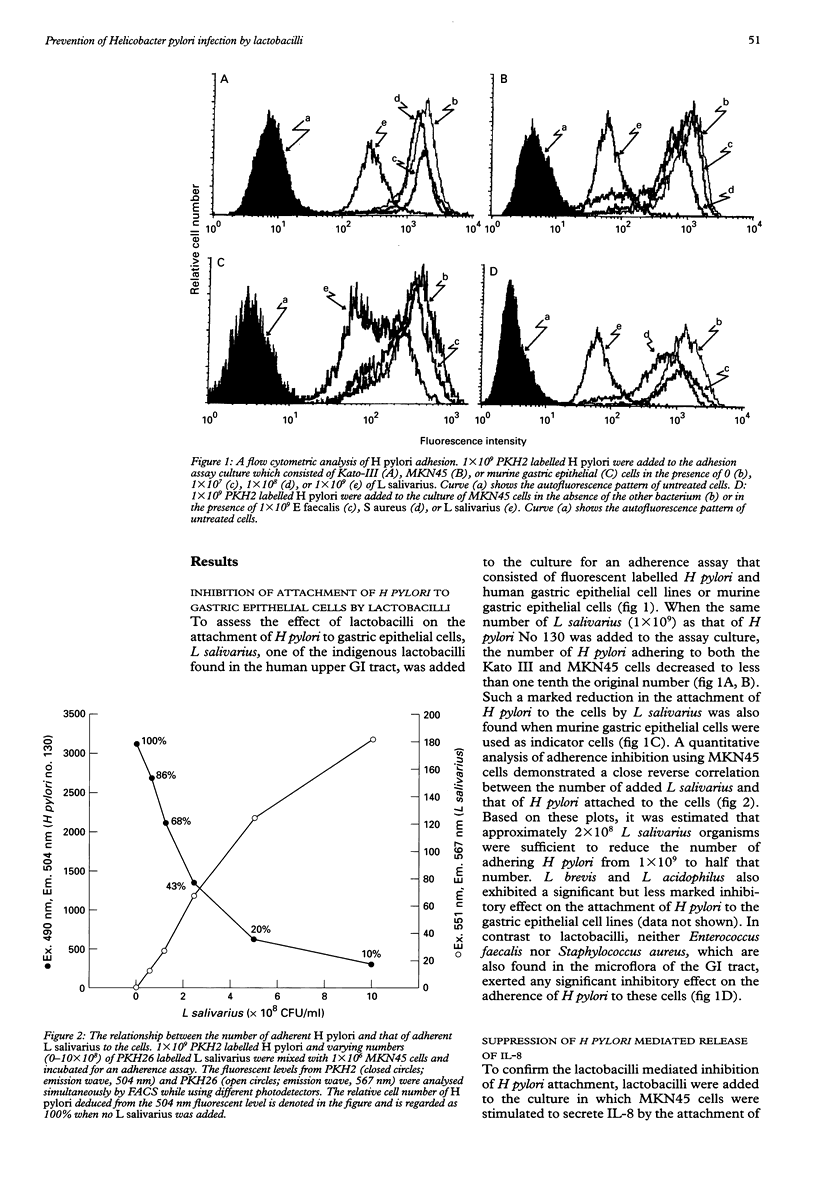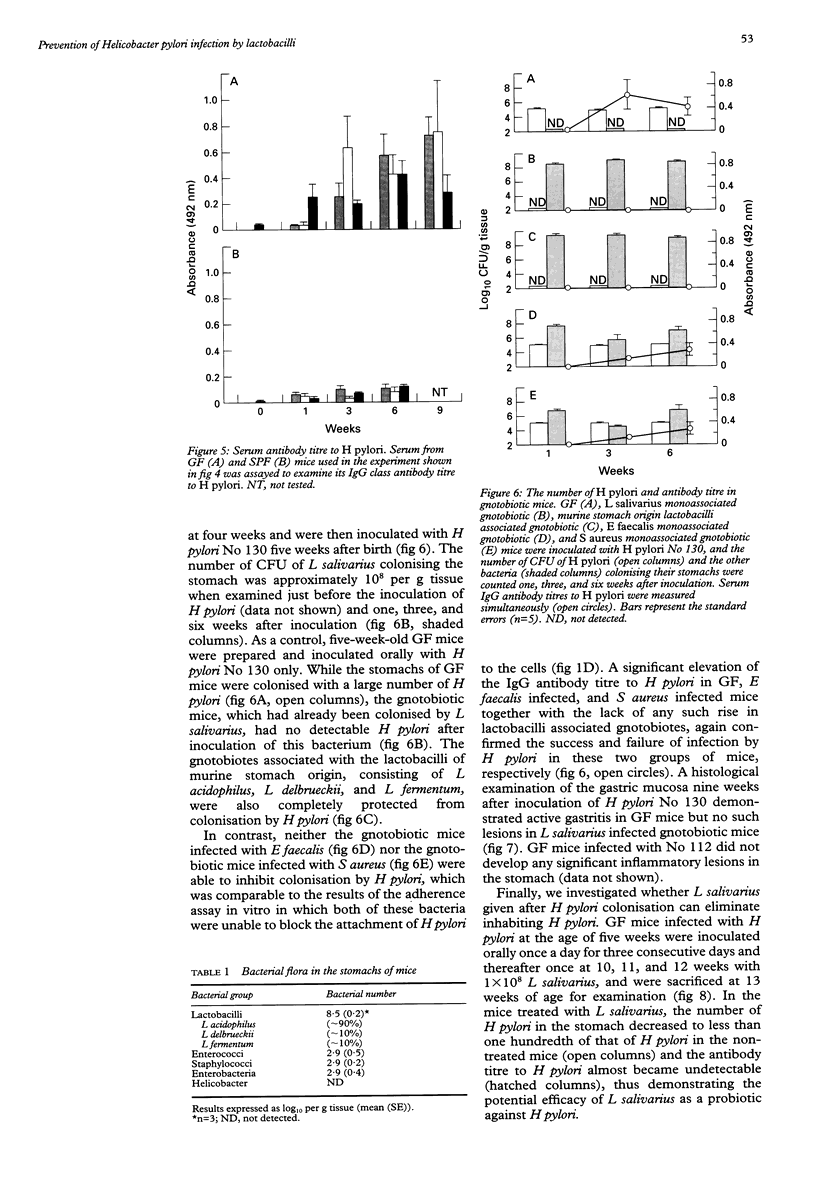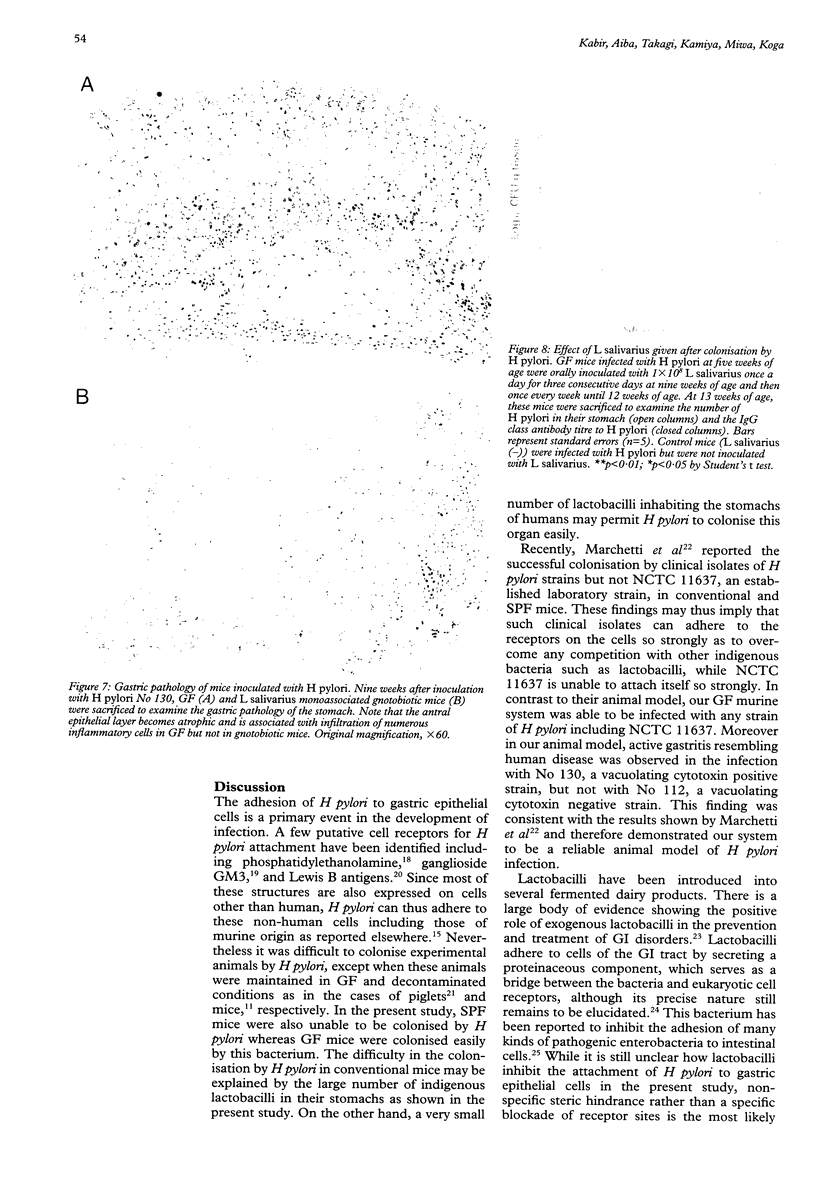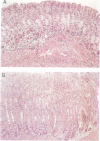Abstract
BACKGROUND: Helicobacter pylori is a bacterium which causes gastric inflammatory diseases. Oral inoculation of H pylori usually results in only a temporary colonisation without a successful infection in the stomach of conventional mice in which lactobacilli are the predominant indigenous bacteria. AIM: To determine whether lactobacilli exert an inhibitory effect on colonisation by H pylori in the stomach. METHODS: The effects of H pylori on attachment to murine and human gastric epithelial cells and the H pylori mediated release of interleukin-8 (IL-8) by these cells were examined in vitro. Lactobacillus salivarius infected gnotobiotic BALB/c mice and control germ free mice were inoculated orally with H pylori to examine whether L salivarius can inhibit colonisation by H pylori. RESULTS: L salivarius inhibited both the attachment and IL-8 release in vitro. H pylori could not colonise the stomach of L salivarius infected gnotobiotic BALB/c mice, but colonised in large numbers and subsequently caused active gastritis in germ free mice. In addition, L salivarius given after H pylori implantation could eliminate colonisation by H pylori. CONCLUSION: These findings suggest the possibility of lactobacilli being used as probiotic agents against H pylori.
Full text
PDF






Images in this article
Selected References
These references are in PubMed. This may not be the complete list of references from this article.
- Bernet M. F., Brassart D., Neeser J. R., Servin A. L. Lactobacillus acidophilus LA 1 binds to cultured human intestinal cell lines and inhibits cell attachment and cell invasion by enterovirulent bacteria. Gut. 1994 Apr;35(4):483–489. doi: 10.1136/gut.35.4.483. [DOI] [PMC free article] [PubMed] [Google Scholar]
- Bhatia S. J., Kochar N., Abraham P., Nair N. G., Mehta A. P. Lactobacillus acidophilus inhibits growth of Campylobacter pylori in vitro. J Clin Microbiol. 1989 Oct;27(10):2328–2330. doi: 10.1128/jcm.27.10.2328-2330.1989. [DOI] [PMC free article] [PubMed] [Google Scholar]
- Borén T., Falk P., Roth K. A., Larson G., Normark S. Attachment of Helicobacter pylori to human gastric epithelium mediated by blood group antigens. Science. 1993 Dec 17;262(5141):1892–1895. doi: 10.1126/science.8018146. [DOI] [PubMed] [Google Scholar]
- Conway P. L., Kjelleberg S. Protein-mediated adhesion of Lactobacillus fermentum strain 737 to mouse stomach squamous epithelium. J Gen Microbiol. 1989 May;135(5):1175–1186. doi: 10.1099/00221287-135-5-1175. [DOI] [PubMed] [Google Scholar]
- Crabtree J. E., Farmery S. M., Lindley I. J., Figura N., Peichl P., Tompkins D. S. CagA/cytotoxic strains of Helicobacter pylori and interleukin-8 in gastric epithelial cell lines. J Clin Pathol. 1994 Oct;47(10):945–950. doi: 10.1136/jcp.47.10.945. [DOI] [PMC free article] [PubMed] [Google Scholar]
- Dunn B. E., Roop R. M., 2nd, Sung C. C., Sharma S. A., Perez-Perez G. I., Blaser M. J. Identification and purification of a cpn60 heat shock protein homolog from Helicobacter pylori. Infect Immun. 1992 May;60(5):1946–1951. doi: 10.1128/iai.60.5.1946-1951.1992. [DOI] [PMC free article] [PubMed] [Google Scholar]
- Dytoc M., Gold B., Louie M., Huesca M., Fedorko L., Crowe S., Lingwood C., Brunton J., Sherman P. Comparison of Helicobacter pylori and attaching-effacing Escherichia coli adhesion to eukaryotic cells. Infect Immun. 1993 Feb;61(2):448–456. doi: 10.1128/iai.61.2.448-456.1993. [DOI] [PMC free article] [PubMed] [Google Scholar]
- Fuller R. Probiotics in man and animals. J Appl Bacteriol. 1989 May;66(5):365–378. [PubMed] [Google Scholar]
- Gold B. D., Huesca M., Sherman P. M., Lingwood C. A. Helicobacter mustelae and Helicobacter pylori bind to common lipid receptors in vitro. Infect Immun. 1993 Jun;61(6):2632–2638. doi: 10.1128/iai.61.6.2632-2638.1993. [DOI] [PMC free article] [PubMed] [Google Scholar]
- Graham D. Y., Adam E., Reddy G. T., Agarwal J. P., Agarwal R., Evans D. J., Jr, Malaty H. M., Evans D. G. Seroepidemiology of Helicobacter pylori infection in India. Comparison of developing and developed countries. Dig Dis Sci. 1991 Aug;36(8):1084–1088. doi: 10.1007/BF01297451. [DOI] [PubMed] [Google Scholar]
- Karita M., Li Q., Cantero D., Okita K. Establishment of a small animal model for human Helicobacter pylori infection using germ-free mouse. Am J Gastroenterol. 1994 Feb;89(2):208–213. [PubMed] [Google Scholar]
- Kobayashi Y., Okazaki K., Murakami K. Adhesion of Helicobacter pylori to gastric epithelial cells in primary cultures obtained from stomachs of various animals. Infect Immun. 1993 Oct;61(10):4058–4063. doi: 10.1128/iai.61.10.4058-4063.1993. [DOI] [PMC free article] [PubMed] [Google Scholar]
- Krakowka S., Morgan D. R., Kraft W. G., Leunk R. D. Establishment of gastric Campylobacter pylori infection in the neonatal gnotobiotic piglet. Infect Immun. 1987 Nov;55(11):2789–2796. doi: 10.1128/iai.55.11.2789-2796.1987. [DOI] [PMC free article] [PubMed] [Google Scholar]
- Marchetti M., Aricò B., Burroni D., Figura N., Rappuoli R., Ghiara P. Development of a mouse model of Helicobacter pylori infection that mimics human disease. Science. 1995 Mar 17;267(5204):1655–1658. doi: 10.1126/science.7886456. [DOI] [PubMed] [Google Scholar]
- Negrini R., Lisato L., Zanella I., Cavazzini L., Gullini S., Villanacci V., Poiesi C., Albertini A., Ghielmi S. Helicobacter pylori infection induces antibodies cross-reacting with human gastric mucosa. Gastroenterology. 1991 Aug;101(2):437–445. doi: 10.1016/0016-5085(91)90023-e. [DOI] [PubMed] [Google Scholar]
- Ohnishi N. Re: Evaluation of new therapy for eradication of H. pylori infection in nude mouse model. Am J Gastroenterol. 1996 Jan;91(1):174–175. [PubMed] [Google Scholar]
- Reid G., Bruce A. W., McGroarty J. A., Cheng K. J., Costerton J. W. Is there a role for lactobacilli in prevention of urogenital and intestinal infections? Clin Microbiol Rev. 1990 Oct;3(4):335–344. doi: 10.1128/cmr.3.4.335. [DOI] [PMC free article] [PubMed] [Google Scholar]
- Slomiany B. L., Piotrowski J., Samanta A., VanHorn K., Murty V. L., Slomiany A. Campylobacter pylori colonization factor shows specificity for lactosylceramide sulfate and GM3 ganglioside. Biochem Int. 1989 Oct;19(4):929–936. [PubMed] [Google Scholar]
- Smoot D. T., Resau J. H., Naab T., Desbordes B. C., Gilliam T., Bull-Henry K., Curry S. B., Nidiry J., Sewchand J., Mills-Robertson K. Adherence of Helicobacter pylori to cultured human gastric epithelial cells. Infect Immun. 1993 Jan;61(1):350–355. doi: 10.1128/iai.61.1.350-355.1993. [DOI] [PMC free article] [PubMed] [Google Scholar]
- Takakura A., Kagiyama N., Sakurai Y., Suzuki H., Kobayashi N., Terada E. Detection of Sendai virus antibody in mouse and guinea pig sera by an enzyme-linked immunosorbent assay with protein A. Jikken Dobutsu. 1988 Jul;37(3):279–283. doi: 10.1538/expanim1978.37.3_279. [DOI] [PubMed] [Google Scholar]
- Umehara K., Yamanaka M., Hashimoto K., Sasaki S. [Nitrogen retention in germ-free and conventional mice reared on an antigen-free diet and the significance of the appearance of protein nitrogen in their feces]. Jikken Dobutsu. 1984 Jan;33(1):77–84. doi: 10.1538/expanim1978.33.1_77. [DOI] [PubMed] [Google Scholar]




